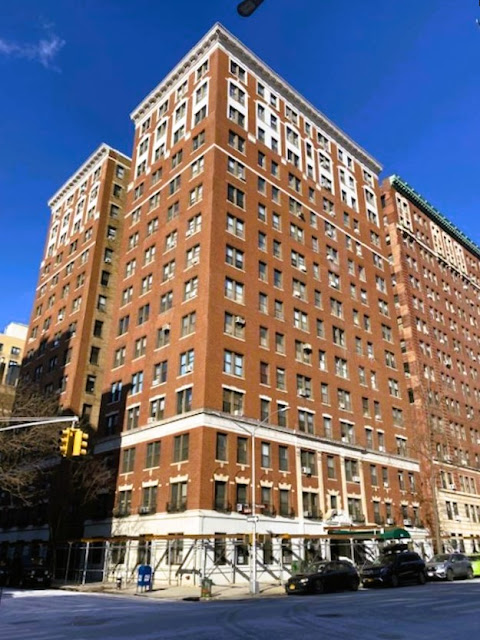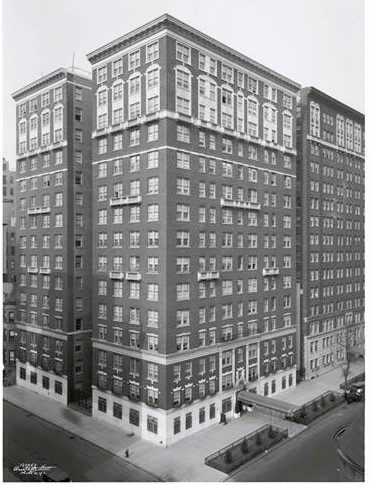photograph by Anthony Bellov
Upon the death of their father in 1899, brothers Charles and Joseph Paterno continued his real estate development business. By the end of World War I they had erected dozens of Manhattan apartment houses. West End Avenue was undergoing significant transformation at the same time, as opulent mansions were being replaced by upscale apartment buildings.
Charles A. Troup and his wife, the former Ella May Lower, had lived in the four-story dwelling at 865 West End Avenue for at least two decades in 1924. That year Paterno Brothers purchased the house as part of the site of their latest project. The firm contracted the well-known apartment house architect Rosario Candela to design the structure.
Completed in 1925, 865 West End Avenue was designed overall in the neo-Classical style. Grounded by a one-story limestone base, the tripartite design was defined by stone bandcourses above the third and eleventh floors. Candela strayed from neo-Classical in giving the second story windows Colonial Revival splayed lintels. He drew the eye upward by embellishing the top section with stone and terra cotta ornament (which did double-duty in lightening the visual bulk of the structure). Apartments ranged from five to seven rooms, with either two or three baths.
Among the early residents were Dr. Sigmund Manheim and his wife, the former Hilda Isaacs. The couple had been married in 1920. On April 11, 1928, Dr. Manheim was summoned to the apartment of another resident, Mrs. Lillian M. Bradley, the widow of millionaire subway contractor James Bradley. He was met by Mrs. Bradley and her son, James Jr. In a bedroom was Ethel Higby, Helen's seriously wounded daughter.
Ethel was the wife of shoe manufacturer Everett Haga Higby and lived in Bronxville. She and her mother had planned to go to a matinee that afternoon. After lunch, Ethel went into a bedroom ostensibly to rest. She wrote notes to her mother and husband "telling them not to grieve and not to wear mourning," according to The Daily Argus. She then shot herself twice in the abdomen.
Manheim accompanied Ethel Higby to St. Luke's Hospital. There, (according to him) he instructed a nurse to notify the police, as was required by law, "but she apparently had forgot to do so," reported The New York Sun. Ethel Higby died that night and the Medical Examiner's staff apprised reporters. "They brought the facts to the attention of the police twenty-four hours later," said the newspaper.
Both Dr. Manheim and James Bradley were arrested--Dr. Manheim for failure to report the attempted suicide and for being instrumental in having her removed, and Bradley for being the owner of the weapon Ethel had used.
Manheim explained that "in the excitement and the because of the grave condition of the patient" he delayed notification and insisted he had instructed the nurse to call. He was set free. And Bradley, who claimed he had not seen the gun in two years, produced a permit and was also released.
The overlapping J and P in the cartouche above the entrance were the monogram of Joseph Paterno, president of Paterno Construction. photograph by Anthony Bellov
Another resident physician, Dr. B. Bookstaver, seems to have had a secret. In December 1932 he received extortion threats from 28-year-old William Taylor. Whatever Bookstaver wanted kept private, it was serious enough that Taylor felt it was worth $200 hush money (about $4,000 in 2023). The doctor met Taylor at 104th Street and Riverside Drive on December 7 and handed over the cash. Once Taylor took it, undercover detectives pounced. He was charged with extortion.
Living in the building at the time was retired contractor William J. MacDonald and his wife, the former Adelaide Brady. Born in Ireland in 1860, he had come to the United States in 1873. The couple had three adult daughters, Helen, Josephine and Agnes. MacDonald was formerly associated with M. Reid & Co. which built structures like the Ritz-Carlton Hotel in Manhattan.
Alexander J. MacDonald, who lived here at the same time, was seemingly unrelated to William. And yet, he, too, was a retired contractor, having been associated with Richards & Gaston for years. He and his wife Ellen had an unmarried daughter, Elizabeth, who shared their apartment, and two adult sons.
The two men's lives, which had been uncannily parallel, ended the same way. Alexander J. MacDonald died on New Year's Day 1933 at the age of 67. His funeral was held in the Church of the Ascension on West 107th Street on January 5. The next day William J. MacDonald died at the age of 73. His funeral was held in the same church on January 9.
The brickwork was laid to create a diamond pattern. Sadly, the Federal and Adams style decorations that framed the windows was removed in the last half of the 20th century. photograph by Anthony Bellov
Among the residents was cigarette manufacturer Theodore Georgopulo. At the time of the MacDonalds' deaths, his health was failing, causing him to become increasingly "despondent" as worded by the Daily News. It finally became too much for him to handle and on the afternoon of January 9, 1935 he climbed to the roof and jumped. He was, of course, killed instantly.
The crisp detail of the delicate neo-Classical lobby plasterwork, softened by layers of paint, still oozes elegance. photograph by Anthony Bellov
The building remained relatively free of scandal until the fall of 1939. Henry Abrams was a well-to-do wholesale meat dealer who had a lucrative contract with the Matteawan State Hospital for the Criminal Insane. He was arrested on October 26 on charges of "conspiring to defraud the State of New York." At his trial in April 1940, prosecutors presented evidence that he had charged the state for deliveries of thousands of dollars of meat that never happened.
Resident William Kron brought attention to the address in 1943. He had been money manager to lyricist Lorenz Hart, who died on November 22 that year. The troubled 48-year-old had struggled with alcoholism and closeted homosexuality. He left one-third of his substantial estate to William Kron. Hart's brother Teddy and his wife Dorothy almost immediately sued to have the will overturned.
According to Fredrick Nolan in his Lorenz Hart--A Poet on Broadway, Teddy Hart "charged that because his brother 'lacked mental sobriety for the last few years because he was addicted to alcohol,' William Kron had exerted undue influence on Larry." Kron counter-petitioned, insisting he had no part in the making of the will.
Colorful octagonal tiles form a carpetlike mosaic runner on the upper floors--a signature detail of early Candela design. photograph by Anthony Bellov
Another resident highly involved in the construction industry was Samuel J. Roth who, with his wife Anna, lived here by mid-century. Born in 1895, he graduated from Cooper Union in 1917 with a civil engineering degree. In 1953 he formed the Sutherlin Corporation, which was responsible for erecting large apartment developments in New Jersey and New York, including the 1,300-family Elmwood Gardens in East Paterson, New Jersey.
Early in the summer of 1956 Noah and Toni Greenberg and their two daughters moved into apartment 10-A, and simultaneously leased the then undivided ground floor space for choral conductor Greenberg's New York Pro Musica, founded four years earlier. That space would house the organization's instruments, rehearsal studio, library and office until the lease ran out on July 1, 1963.
According to James Gollin's 2001 book Pied Piper, The Many Lives of Noah Greenberg, "The ground-floor space rented for $183 a month. By the grace of New York City's rent-control statutes, the rent for Apartment 10A, if Noah's and Toni's daughters remember correctly what their parents told them, was $185 a month." (If the women were accurate, that amount would translate to an affordable $1,850 per month in 2023.)
Greenberg had originally named his ensemble Pro Musica Antiqua. The vocal and instrumental group specialized in Medieval and Renaissance music. It disbanded following Noah Greenberg's death in 1966.
Another well-known musical resident was jazz arranger, trumpeter, composer, bandleader and singer Melvin James "Sy" Oliver. Born in Battle Creek Michigan in 1910, he had left home at the age of 17 to play with Zack Whyte and his Chocolate Beau Brummels.
By the time he moved into 865 West End Avenue in 1969, he had arranged for bandleaders like Jimmie Lunceford, Paul Whiteman, Sammy Kaye, and Jimmy Dorsey, and artists like Ella Fitzgerald. Among his compositions were "Yes, Indeed, " "Swinging' on Nothin'," and with Trummy Young, "T'ain't What You Do (It's the Way That You Do It."
many thanks to historian Anthony Bellov for suggesting this post
no permission to reuse the content of this blog has been granted to LaptrinhX.com








.png)
Isaac Stern also lived here. It's mentioned in his memoirs.
ReplyDeleteWow what a history! They were not kidding when they coined the phrase "If those walls could talk". During my 7+ year working with reknowned Librarian and collector Vivian Davidson Hewitt who was most recognized for the Hewitt Collection of African American Art, it was also rumored during my daily elevator trips to the 7th floor that Gershwin, Castro and a few others would meet regularly to play cards on the 12th floor. I wonder what other juicey tid bits are not yet told.
ReplyDeleteI am a fan of your blog and always find it well-written and very informative. Occasionally, even frustrated, as I was with the bit of info you shared on William Kron. I needed to find out how the will of Lorenz Hart was finally resolved. What an incredible tale that turned out to be. If you care to discover iit yourself, check out: https://books.google.com/books?id=RHAaz72MYAAC&lpg=PA236&ots=OZOtOT0VJL&dq=William%20Kron%20Lorenz%20Hart&pg=PA236#v=onepage&q=William%20Kron%20Lorenz%20Hart&f=false Again, congrats on your blog. Where do you find the time?
ReplyDelete